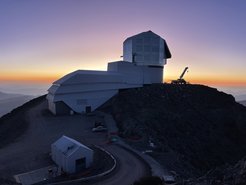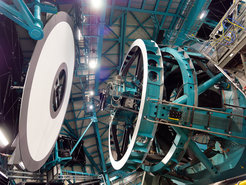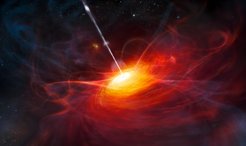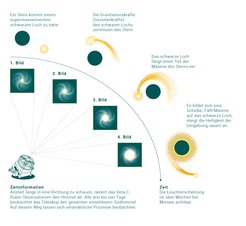First images of the Vera C. Rubin Observatory
The first images from the observatory will be published on 23 June 2025 at 17:00 CEST. Researchers from the Max Planck Society report on their planned research

To the point
- First images: On 23 June 2025, the Vera C. Rubin Observatory will release its first telescope images, marking the start of scientific operations. Media representatives are invited to attend the presentation of the first images in a hybrid event at the Haus der Astronomie in Heidelberg or online.
- Comprehensive sky survey: The observatory will conduct a ten-year survey of the southern sky, investigating the influence of dark matter and dark energy on the distribution of galaxies in the universe, as well as variable phenomena such as supernovae and the flaring of galaxy cores when they swallow matter.
- Telescope of records: With an 8.4-metre telescope and the world's largest digital camera, the observatory captures large amounts of data.
- Participation of Max Planck Researchers: Astronomers from the Max Planck Society hold rights to the observatory's future data and explain their science goals in this article.
On Monday, 23 June 2025, at 5 p.m. CEST, the Vera C. Rubin Observatory will publish its first telescope images. This ‘first look’ is a milestone on the road to scientific operation. Impressive images are expected that will demonstrate the capabilities of the observatory and its 3,200-megapixel camera, similar to the first images from the Euclid space telescope before it began its survey of the sky. The Astronomical Computing Centre, which is part of the Centre for Astronomy at Heidelberg University, and the Max Planck Institute for Astronomy are involved in the project and are contributing to the software development. This gives them preferential access to the telescope's data. In addition, a number of astronomers from the Max Planck Society already hold rights to data that the observatory will record as part of the Legacy Survey of Space and Time (LSST).
Media representatives are invited to attend the presentation of the first images together with researchers from the Astronomical Computing Institute and the Max Planck Institute for Astronomy in a hybrid event at the House of Astronomy in Heidelberg or online and to talk to the experts. Members of the press are requested to register by Sunday, 22 June 2025, by emailing pr@mpia.de. The First Look Event can also be followed on the observatory's website.
A telescope of many records

The Vera C. Rubin Observatory in Chile is a joint project of the US National Science Foundation and the US Department of Energy's Office of Science. At its heart is the 8.4-metre Simonyi Survey Telescope, equipped with the largest digital camera ever built, the 3,200-megapixel LSST camera. With each image, the camera captures an area of the sky more than 40 times the size of the full moon. Thanks to the speed of the telescope drive, the Vera C. Rubin Observatory will completely image the southern sky every three to four nights. The sky survey – called the Legacy Survey of Space and Time (LSST) – will last ten years and will ultimately image the entire visible sky about 800 times. Researchers expect a data set of around 40 billion celestial objects, including stars in the Milky Way, distant galaxies and even objects in our solar system such as asteroids.
The observatory not only combines high sensitivity with speed, but also features a novel computer infrastructure. Thanks to its enormous computing power, it can process around 20 terabytes of data every night and record up to ten million changes in the objects observed in the sky. "This decade marks a transformative era in astronomy, with an unprecedented surge in data volume and a boom in survey-based science", says Esra Bulbul, an astronomer at the Max Planck Institute for Extraterrestrial Physics in Garching near Munich. “It’s an exciting time not only for observational astronomers but also for theorists, as the increasing precision and scale of data open up new opportunities to uncover previously unknown physics.”
The scientific focus areas coincide with the research interests of several Max Planck Institutes and include, among others, the study of dark matter and dark energy, mapping the Milky Way, and observing short-lived phenomena such as star explosions, asteroids, and the incorporation of stars by supermassive galaxies.
On the trail of dark matter
“The Vera Rubin Telescope will be transformational for my research in cosmology," says Esra Bulbul, astronomer at the Max Planck Institute for Extraterrestrial Physics. "With its wide field of view and depth, it will observe billions of galaxies across vast distances, allowing me to study the large-scale structure of the Universe and its evolution over time.” This is how Esra Bulbul is tracking down the dark components of the universe, which make up about 95 percent of the universe. Data from previous telescopes already show that there must be invisible dark matter that permeates galaxies and galaxy clusters and holds them together. Researchers hope that the data from the Vera C. Rubin Telescope will provide better clues as to how dark matter influences the evolution of galaxies and how dark energy influences the expansion of the universe. There are parallels here with the research of Vera Rubin, after whom the observatory is named. She was one of the first to discover this invisible mass.
Adult galaxies in the kindergarten of the universe

In addition to the large number of galaxies, the Vera C. Rubin Observatory will also be able to see them from a great distance. Thanks to the large mirror and the particularly sensitive camera, Eduardo Bañados from the Max Planck Institute for Astronomy in Heidelberg will be able to study very young galaxies with growing black holes. “These are the galaxies that existed when the universe was just a baby – less than a billion years old.” Since the universe has been expanding in all directions since then, Bañados finds these galaxies mainly at large distances – so far away that their light has taken many billions of years to reach Earth. Researchers are puzzled as to how these young galaxies can already have black holes with considerable mass at their centres. According to current thinking, black holes grow by attracting matter from their surroundings over a long period of time or by merging with other black holes. “The young galaxies shouldn’t have had enough time to grow so massive black holes – even thousand times more massive than the black hole in our own Galaxy, the Milky Way”, says Bañados. “It’s like discovering a full-grown adult in a kindergarten class!” However, long-term observations of such galaxies are still lacking. “The LSST survey is exciting because it will provide us with a cosmic movie. This will allow us to go beyond just discovering such super distant galaxies, but also learning about their physical properties”, says Bañados. The flickering of the bright galaxy core, for example, reveals how the central black holes consume matter. And perhaps this holds the key to the enormous growth spurts that some black holes and their host galaxies must have undergone.
When black holes swallow stars

Click the + - symbol for an enlarged view.
In addition to mapping stars and galaxies, one of the main objectives of the Vera C. Rubin Observatory is to study time-variable phenomena in the sky. The Observatory will not only investigate how active galactic nuclei flicker, but also observe how stars explode, known as supernovae. A special type of explosion is the kilonova, in which two stellar corpses, compact neutron stars, collide and produce heavy elements such as gold. However, only a few kilonovae have been observed so far. The Legacy Survey of Space and Time aims to change that.
Elias Mamuzic from the Max Planck Institute for Astrophysics in Garching near Munich is interested in a very special form of stellar death: tidal disruption events. Here, a star comes so close to a supermassive gravitational trap at the centre of distant galaxies that the immense tidal forces of the black hole tear it apart. The remains of the star gather in a disc around the black hole and feed it for weeks and months. During this process, the centre of the distant galaxy flashes and only returns to its original brightness after months. “It seems as if we have been missing out on a lot of these events so far”, says Elias Mamuzic. "By simply observing the entire sky we will try to catch every event." The fact that the sky survey captures every spot every three to four days also allows the collected data to be used to reconstruct exactly how the tidal disruption event unfolds, in particular how large the disc of gas forming around the black hole actually is.
An icon as namesake
Like all sciences, astronomy was even more male-dominated back then than it is today. Nevertheless, not all the stories of those women without whom the fields of astronomy and space travel would not be where they are today, have been told.
In a separate article, we tell the story of Vera C. Rubin and how she persevered despite facing substantial external opposition. “Her research fundamentally changed our understanding of the Universe and helped establish dark matter as a cornerstone of modern cosmology”, says Esra Bulbul. “Vera Rubin has long been one of my role models. My students and I are building on her legacy and aiming at finding out the nature of dark matter.”
BEU



